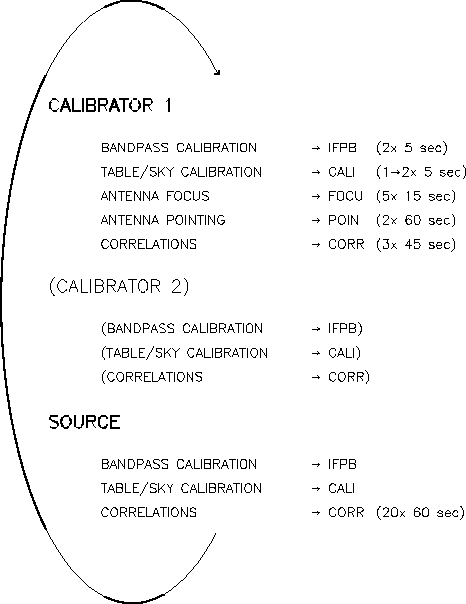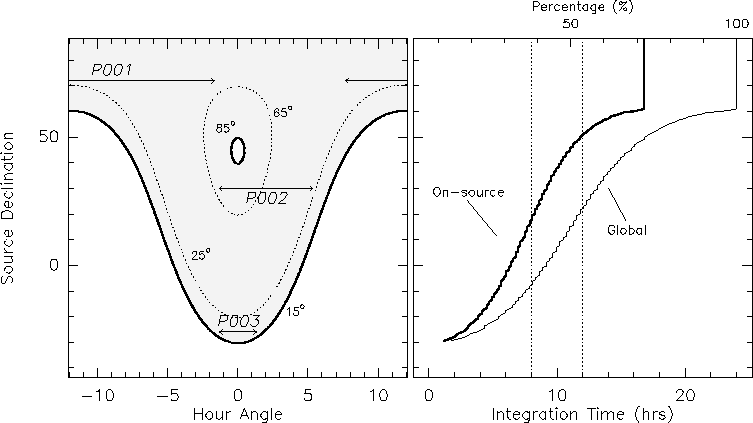 |
Since projects are spread over typically a few months, it is impractical that astronomers actually come to the interferometer for their observations. In some exceptional case, however, when observations require rapid decisions, the presence of a visiting astronomer may become necessary. Up to now and after almost ten years of operation, only a handful of projects required the presence of a visiting astronomer. Only non-standard observations like mapping of fast moving objects, coordinated observations may require a member of the project team to be present on the site. All observations are carried out ``in absentee'', and a local contact is assigned to each project.
The observer has to specify all aspects of his/her program in an observing procedure. For routine observations, this is usually done with the help of the local contact by parameterizing the general observational procedure. Once the procedure is written, a copy is made available to the operation center at Plateau de Bure. Before start, further verifications will be made by the scientific coordinator and, to finalize the procedure, by the astronomer on-duty who makes a last check by looking at the technical details in the proposal, at the technical report and at the recommendations made by the programme committee.
Quite some time, however, may pass between the preparation of an observational procedure and the actual observations. Depending on the requirements, between a few hours and a few months may go for the decision to start the observations. On average 90% of the projects are completed within 6 months from their acceptance.
For the observations, the array is operated by an operator with the assistance of an astronomer and under the supervision of the scientific coordinator. The operator has the full responsibility for conducting all observations following pre-established observing procedures or with the help of the astronomer in case of unpredicted events.
The operator will execute the observing procedure according to a pre-established planning which allows for some flexibility in the scheduling, and to a few criteria (as the maximum amount of precipitable water in the atmosphere, the required atmospheric phase stability, the requested observing frequencies, the declination of the targets, the sun avoidance limit and a few other aspects) which will help both the operator and the astronomer in their final decision-making on which project to carry out as next. As a rule, excellent atmospheric conditions will be used for high grade projects requesting sensitivity at high frequencies while the remaining time will in general be devoted to projects which require less stringent atmospheric conditions.
Once a project is selected, the operator will start the observing procedure which sets up the needed equipment configuration (essentially sky frequencies, correlator settings and target coordinates according with the observer's wishes) and will start preparing the interferometer for the observations: the receivers are tuned, the gains and the zero-delay of the receiving antenna is adjusted and verified, the antenna pointed and focused, the RF passband is measured and the temperature scale of the interferometer calibrated. The flux of the primary calibrators are then verified, eventually replaced if their flux density has dropped too much, and the observations started.
As soon a project is started, the astronomer on-duty will monitor the execution of the project and the data quality by examining the visibility amplitude and phase of the calibration sources, the antenna tracking in presence of wind, the antenna pointing corrections, and all time-dependent instrumental and atmospheric parameters which could have some implications on the observations. Furthermore, to avoid further observing on a target with wrong coordinates, the astronomer will verify the presence or absence of line and/or continuum emission according to the expected values quoted in the proposal. Finally, the astronomer on-duty will provide pre-calibrated data on a best effort basis. Depending on project complexity and needs, further data analysis is sometimes required on the site to decide on follow-up observations.
 |
When the observations are running, commands are regularly issued to the antennas and to the peripheral equipment (phase rotators, correlators and others) following a well-defined, cyclic sequence as shown in Figure 6.2. This sequence may slightly change depending on the number of calibrators and on the number of phase centers (i.e. the fields of view requested for different sources or for mosaic-type observations) the observer wishes to track in a single run. Typical observations at Plateau de Bure fall in one of the following categories:
Under normal circumstances only a few parameters of interest are regularly verified and corrected (mostly automatically) during the observations, but instantaneous (every second) and much more detailed information can be obtained at any time by connecting to the equipment (receivers, antenna control parameters, digital correlator units and others). During the operation the array status is continuously monitored so that the operator can provide fast feedback in response, at any time when necessary. An automatic data quality assessments (flagging bad data, antenna shadowing, receiver phase lock and others) before writing data to disk. The astronomer on-duty has the responsibility of periodically monitoring the data acquisition and to write a few notes assessing the data quality during and after the observations. Monitoring the progress of a project by making intermediate data reductions, however, is the responsibility of the observer. This is not the responsibility neither of the astronomer on-duty nor of his/her local contact.
 |